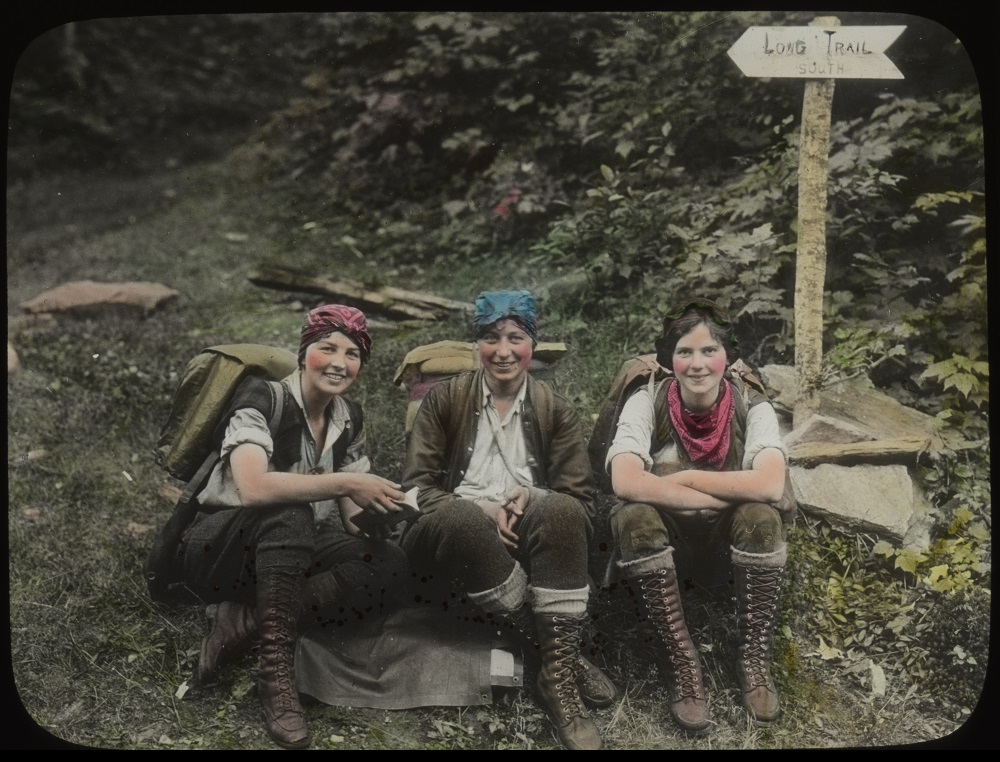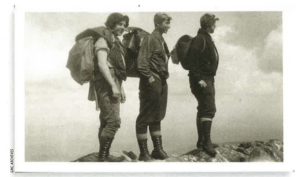 This article about the first women thru-hikers of the Long Trail first appeared in the Fall 2008 Long Trail News under the headline “Without Male Escort or Arms: The Three Musketeers’ 1927 Traverse of the Long Trail” and was written by Reidun D. Nuquist.
This article about the first women thru-hikers of the Long Trail first appeared in the Fall 2008 Long Trail News under the headline “Without Male Escort or Arms: The Three Musketeers’ 1927 Traverse of the Long Trail” and was written by Reidun D. Nuquist.
“Girl Hikers Reach Canadian Line after Walking 300 Miles” proclaimed the Rutland Herald on August 25, 1927. “’Three Musketeers’ Make 300-Mile Trip Over the Long Trail In 30 Days” echoed the Burlington Free Press a few days later. Similar headlines ran in newspapers across the country—never mind that the Long Trail is not, and never was, quite that long. The fact that women had hiked the length of Vermont alone was astonishing news.
Ready for Adventure

The young Musketeers, our first female end-to-enders, were Hilda M. Kurth and Kathleen M. Norris of Schenectady, New York, and Catherine E. Robbins of Cornwall, Vermont. Catherine, a Schenectady teacher, and Hilda, an instructor of mathematics at Brandon High School, had hiked extensively in Alaska the summer before. Kathleen, Hilda’s student and a recent high school graduate, was the one who conceived the idea of the Long Trail adventure. She was a member of the Green Mountain Club, “had heard many discussions of the Trail . . . and visited parts of it.” Now, she wanted to hike the Long Trail before entering college.
The Three Musketeers—we don’t know who came up with the moniker—left Williamstown, Massachusetts, on July 25. Each woman carried between 20 and 25 pounds. This sounds light when we learn that provisions included dehydrated vegetables, powdered milk, baking and pancake flour, macaroni, cheese, bacon, crackers, raisins, chocolate, oatmeal, cornmeal mush, and mapleine, which turned into ‘maple syrup’ with the addition of sugar and water.
The women’s packs also held blankets, ponchos, flannel pajamas, first aid kit, matches, hatchet, Kodak camera, two axes, and three compasses. The Musketeers wore flannel shirts with pockets, breeches, and white lisle stockings, “to keep the dye from getting on to their feet,” inside heavy wool socks in high 14 inch lace-up boots with moccasin toes. (Lisle is a smooth, twisted cotton yarn.)
On the Long Trail
As pioneer hikers on the young and still incomplete Long Trail, the trio had many adventures. They got to practice their compass skills the very first day out when they lost the trail outside Bennington. Near Bourne Pond they found the white blazes leading them across a railroad trestle—sixty feet above a rushing stream. The intrepid hikers crawled across on their stomachs, packs on their backs, advancing two inches at a time, rotting timbers crumbling in their hands as they held on to keep their balance. Their conclusion: the LT ought to be rerouted to a ford across the stream. Around Styles and Peru Peaks they encountered a tangle of recent blow-downs, and wasted two hours edging their way through the maze, all the while trying to keep the trail in sight.
People they met along the way seemed captivated by the women backpackers, and the Musketeers responded graciously to the attention. They had been warned in advance not to associate with fern pickers, local seasonal workers who made extra money by gathering and shipping ferns to city florists. But Hilda, Catherine, and Kathleen found the fern pickers friendly and interesting, and lingered in their lumber camp, listening to stories. At Sherburne Pass, the women’s overnight hostess, Mrs. Griffin, presented Kathleen with a green felt hat, which she proudly wore the rest of the way, rain or shine, to remember her by; the other two wore bandannas. They were escorted up Mount Mansfield by gallant U. S. Artillery soldiers who offered to carry their packs.
Reporting In
On August 20, the women had reached Ed Derby’s farm north of Johnson, an overnight stop for early hikers. From there, Kathleen wrote to James P. Taylor, founder of the Green Mountain Club and now executive secretary of the State Chamber of Commerce:
Dear Mr. Taylor:
This is to let you know that we, “the Three Musketeers,” left Mt. Mansfield Friday morning, stayed at Whiteface Lodge Friday night and reached here tonight. . . . I will drop you another line from Albert Deuso’s, another farm on the trail [in Montgomery Center], and will call you from North Troy. . . .
It is very kind of you to be so interested in our trip. We received so much discouragement at first.
Kindly excuse the stationery—as it is all the place has to offer.
Sincerely,
Kathleen M. Norris
Taylor made sure that the Three Musketeers were well anticipated and well received as they entered the final miles of the Long Trail. On August 24, the Rutland Herald reported that the women were camped on the slopes of Jay Peak. They had ignored rain and hail, wrote the newspaper, sometimes sleeping on bare ground with just a blanket and the sky as their cover. “They have had no scares and have carried no firearms and have scorned male escorts.”
Read “Modern Girls,” a poem by Irving D. Appleby, dedicated to the Three Musketeers
Canada Within Sight
The next afternoon, Mr. Hammond, Town Clerk of North Troy, Mr. and Mrs. Fred Kelley, and Harold F. French of the State Chamber of Commerce hiked up Jay Peak to meet the Musketeers. As the Long Trail stopped at Jay Peak at the time—it did not reach Canada until three years later—the women then hiked down the east side of the mountain to the highway, which they walked for eight miles through North Troy to the border, arriving at 5:35 PM. E. C. Jenkins and L. P. Thayer of the Chamber were there to greet them. A movie camera recorded the arrival ceremony. Upon returning to North Troy, the hikers were whisked away to a beefsteak and ice cream dinner attended by more Chamber dignitaries and townspeople.
Upon being interviewed about their news-breaking accomplishment, the Musketeers thought that for those who liked the outdoors, the Long Trail hike was “the most wonderful trip possible.” They suffered no blisters and had lost little weight, but had “hardened up a bit.” When they were wet and tired, they had brought out a four-ounce ukulele, singing “the peppiest songs they could think of.” The most ferocious beast they encountered on the trail was a hedgehog, four feet up a tree, which Catherine expedited with her hatchet. (Those were the days when the Long Trail guidebook encouraged hikers to kill porcupines on sight because of the damage they did to shelters.) In all, the women spent twenty-seven days hiking, not counting five rest days.
The First Women Thru-Hikers Reception
The Three Musketeers created nationwide publicity for the Long Trail and the Green Mountain Club. Much of it was orchestrated by James Taylor and the State Chamber of Commerce. Taylor firmly believed that the Long Trail was a major Vermont asset, a draw for tourists, and a boon to the state’s economy. (He was also an advocate of improved and beautified highways.) Actively working with Taylor to advertise the trail were GMC President Mortimer R. Proctor and director of the Vermont Publicity Department Walter H. Crockett. Wrote Crockett to Taylor in September 1927:
I think I ought to warn you that you should not allow your admiration for these lovely ladies who traveled along the Trail to cloud your judgment. I saw their pictures in The Times and realize that this was the very best kind of advertising. It is good for The Long Trail and introduces the young ladies to a large circle of friends.
Proctor thought the women were “quite an asset to us” and that 1927 was a banner year for publicity.
Did the Three Musketeers inspire other women to try long-distance hiking?
They were most certainly responsible for some increase in numbers—although we have no statistics to prove it; GMC did not start tracking LT end-to-enders until 1943. What we do know is that women have been on the Long Trail since its very inception—although it took a while before they assumed leadership positions in the Green Mountain Club. (Theresa L. Davis in her article “Women on the Long Trail,” LTN, Spring 1995, gives a good account of early women hikers.)
Today, female long-distance hikers are no longer news. Countless women have hiked the Long Trail, the Appalachian Trail, the Pacific Crest Trail, and other trails end-to-end, many of them solo. But then we women knew all along what we were capable of. So did young Cara Clifford Nelson and Amity Clifford who hiked the Long Trail in 1997 in honor of their grandmother Catherine Robbins Clifford. Mrs. Clifford died the following year at age ninety-six in Rutland, the last surviving Musketeer.
Reidun Nuquist of the Montpelier Section, a regular contributor to the Long Trail News, has a special interest in Vermont and GMC history. She is a Long Trail end-to-ender.
In honor of Women’s History Month, GMC will be sharing stories of tenacious women past and present who have shaped the Long Trail, the Green Mountain Club, and the world of outdoor recreation and conservation as a whole. Stay tuned on the blog, Facebook, Instagram, and Twitter, and as always, we welcome your stories of strong women on and off the trail at [email protected]



















Wonderful article! Thanks for the inspiration.
Such a wonderful tribute to these women and to long-distance hiking! Thank you for sharing.
Thanks for that good read!
Love the story of these three remarkable women who inspired many other women including me at age 54 to hike over 100 miles of the trail with my son. Only a family member’s illness caused us to leave the trail before completion.
What an inspiring story. These women sure were leaders of their time. Thank you so much for sharing.